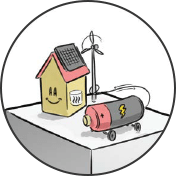
10 challenges
This route describes ten important and urgent Challenges that need to be addressed in long-term programming in close collaboration between public and private parties.
Buildings as power plants and vehicles as energy buffers
Not only can buildings and vehicles be made much more energy-efficient, they can also be given an active role in the energy system. New and better technologies, products and services can optimise the energy performance of buildings, building clusters or urban areas (highly energy-efficient, energy-neutral or even energy-generating) and combine this with comfort, convenience, attractiveness and lower running costs, making large-scale application possible. In addition, the fast, cheap, low-risk and low-impact ‘deep renovation’ of existing buildings makes it possible for the large existing stock to successfully contribute to the energy transition. Buildings and vehicles act as buffers (for heat and/or electricity) between a variable energy supply and demand. Market models and legislation are optimised for such applications. Owners, operators and users are encouraged and motivated to use buildings and vehicles for this purpose.

Clean and flexible industry
Not only can buildings and vehicles be made much more energy-efficient, they can also be given an active role in the energy system. New and better technologies, products and services can optimise the energy performance of buildings, building clusters or urban areas (highly energy-efficient, energy-neutral or even energy-generating) and combine this with comfort, convenience, attractiveness and lower running costs, making large-scale application possible. In addition, the fast, cheap, low-risk and low-impact ‘deep renovation’ of existing buildings makes it possible for the large existing stock to successfully contribute to the energy transition. Buildings and vehicles act as buffers (for heat and/or electricity) between a variable energy supply and demand. Market models and legislation are optimised for such applications. Owners, operators and users are encouraged and motivated to use buildings and vehicles for this purpose.

Every surface generates sustainable energy
Sustainable energy generation is a corner stone for a sustainable energy economy. This means highly efficient and cheap solar, wind and geothermal energy applied on a large scale and in an attractive, socially acceptable way in the limited space available in the Netherlands: buildings, infrastructure, landscape (including inland waters and the sea) and the subsurface. Sunlight-toelectricity conversion efficiency needs to double. Flexible solutions need to be developed for integration and function combination in buildings and other objects. Fuel production using sunlight will become a fully-fledged component of the energy system. The potential for the compound use of the sea (combinations of wind, sun, bio-energy, bio-materials and energy storage) will be unlocked and the value of offshore wind energy will increase. The use of geothermal energy will be economically sound and sustainable. Integrated spatial development models will support the large-scale introduction of sustainable energy generation.

Intelligent energy systems
ICT, partly based on new developments in mathematics and computer science, is needed to realise the future energy system as this will be more complex than the current one, both technically and organisationally. Advanced ICT combined with smart networks is required to get centralised and decentralised sections of the energy system and its users working effectively and efficiently together with the variations over various timescales (from very short to hours, days and seasons) and to guarantee reliability, availability and affordability. The collection and use of big data that is relevant for generation, storage, distribution and consumption is crucial in this. Furthermore, ICT can stimulate users to make sustainable use of energy and can be used to achieve energy savings. Critical design factors are public acceptance, ethical aspects, autonomy, robustness, privacy and cyber security.

From electricity to fuel and heat
Parts of the transport sector, such as aviation and freight transport, as well as industry, depend on fuels with a high energy density and on high-temperature heat. To increase the sustainability of these sectors, scalable, cheap and efficient chemical processes are required that convert electrical energy into fuel using biomass, captured CO2, nitrogen or water. Technologies are also needed for the cheap and efficient conversion of electricity into high-temperature heat. This requires research into new, efficient electrocatalytic and electrochemical processes with a high product selectivity, including research into new catalysts based on abundant elements.

Dealing with variation
Energy supply and demand will vary in time and place in the future energy system. This therefore requires research and development on flexibility on the side of the energy consumers, with user behaviour and acceptation as important factors. Also important is the development of balancing, transport, distribution and storage technologies for electricity and other energy carriers. These elements will be used in the design and realisation of the integrated energy system. This includes the development of an effective economic system, including markets, governance models and legal frameworks for a society in which an optimum match is achieved with the varying supply of sustainable energy at the various timescales (very short, hours, days, seasons).

Measure, analyse, adjust
It is crucial to measure the effect of the energy transition on emissions of CO2 and other greenhouse gases and to analyse the impact of reduced emissions on climate change. Not just the direct emissions are important, but work must also continue on analysing the greenhouse gas emissions of individual products in the product chain (CO2 footprint). As well as greenhouse gas emissions, secondary effects will be measured, such as improvements in air quality. Such analyses can be used to optimise the pathway chosen. Conversely, we also need to learn more about the effects of climate change on the energy system and beyond so that we can be proactive in limiting the negative effects. Effective communication of the results with all stakeholders, including end users, is important as well.

Rapid switch to a CO2-neutral society
A complete switch to a CO2-neutral energy system within a few decades demands an unprecedented fast rate of innovation and social change. Social, economic and legal instruments that form the basis for very rapid innovation and the application of new practices will need to be developed. Attracting the investments needed for the transition to a sustainable energy system also presents a big challenge. An important theme is how to generate effective incentives to stimulate efficient and sustainable energy use and to reduce emissions. Well-founded policy choices and effective interaction between the general public, the public sector and the private sector are crucial in this. Particular attention is required for the opportunities available to achieve negative CO2 emissions in order to further accelerate the switch to a CO2-neutral energy system.

A CO2-neutral energy society will be different
A CO2-neutral energy system will probably look very different from our current fossil fuel-based society. It is very important to properly understand the changes that will take place due to the transition to a CO2-neutral energy society. Insight into the societal changes within and beyond the energy sector is important to be able to manage the transition process and to adjust it where necessary. Elements of this transition include a different spatial design, a transition to circular processes, new forms of transport, infrastructure for energy carriers (electricity, hydrogen, etc.) and changing lifestyles. Public acceptance of certain solutions will also determine the resulting transition process and societal structure.

The Dutch transition in a global context
The transition to a sustainable energy system is a global process and therefore requires a global approach. It involves international research and policy efforts to learn from one another, to understand the conflicting interests that hinder a sustainable energy transition and why these exist, and to learn how to harmonise interests. It also requires a coherent approach in which the costs and benefits of the transition are evenly distributed. Another requirement is an understanding of cultural differences in preferences, behaviour and acceptance, as well as opportunities for guaranteeing global access to energy while maintaining national security of supply and reducing climate problems. Finally, a comprehensive, global chain analysis of energy and material flows and insight into the effects on people and the environment will enable a socially responsible energy transition to take place. ‘Think global, act local.’